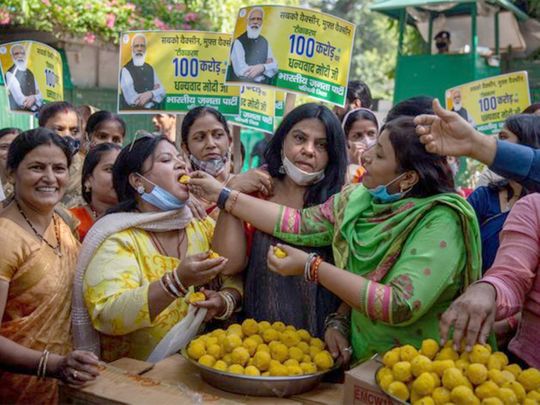
A Bharatiya Janata Party (BJP) worker in Uttar Pradesh told me a few weeks ago how the party was planning to address “anti-incumbency,” that unique Indian term that suggests voters are naturally inclined to change the government in every election. “Party workers and leaders starting with Members of Parliament will spread out to hear the people’s complaints,” he said.
To him, it sounded like an obvious thing to do. To me, it revealed why the BJP often wins elections against all odds. It has a human force of party workers large enough to manage face to face contact with a majority of 220 million voters in Uttar Pradesh. Ditto for the Hindi heartland and beyond.
It sounds like such a simple idea: the party wants to hear your complaints. Usually we think a party machinery only spreads propaganda. In reality, it is more complex.
They also listen. The act of listening before an election, especially when the party is in power, gives voters the sense of being heard. It can even be cathartic. A voter can express anguish and even anger. This way, the anger is not taken out on the voting machine.
1 to 20 in 5 years
Of course, you have to have a party machinery large enough to talk to voters face to face — enough voters to win you the election.
Phulpur in east UP is a place that used to send Jawaharlal Nehru to Parliament. I have visited a village in Phulpur every state and national election since 2012.
Back in 2012, this village had one BJP worker. He was so demoralised that he conceded his party was going to do badly in that assembly election. By 2017, the village had 20 party workers. This is the greatest achievement of Amit Shah, who as party president undertook a party expansion exercise.
The small picture
In a speech Amit Shah once credited Whatsapp with making sure the BJP message reaches millions of people instantly. When Shah himself says this, it’s fair for the media and political analysts to think that social media is behind the BJP’s stupendous success. People also point out how newspapers and news TV have aligned themselves with the BJP narrative.
Amid this noise about TV and Whatsapp, the BJP worker is underrated. Most people have only one smartphone in the house, and data is limited to 1.5 GB a day.
They do watch TV News a lot, but TV news gives them the big picture, the national news, the big events even at the state level. Neither WhatsApp nor TV tell them why they shouldn’t be angry with the BJP about inflation. It’s the party worker who performs this most important role.
Rhetorical persuasion
So, what about inflation? I asked a BJP worker in Phulpur. “It’s only petrol and diesel that’s become really expensive,” he said, downplaying the inflation. “Do you remember how much pulses used to cost in the UPA era? Besides these days people are getting free ration, about 25kg rice per person.”
This is the typical style of rhetorical persuasion that BJP workers use to convince voters to stay with BJP despite all their complaints. The answers do not always sound ‘reasonable’. These answers are often like counterarguments, what in Hindi is called “tark-vitark”.
The all-weather salesman
In 2017, I met a Yadav voter in a village who said he was going to vote for the BJP because his ‘own party’, the Samajwadi Party, wasn’t even asking for his vote. The candidate hadn’t arrived at his doorstep, and neither had any party worker.
This tells you the importance of good old face-to-face campaigning that no technology will ever replace. Similarly, Muslim voters often say they feel humiliated by “secular parties” who take their vote for granted because often there’s no party worker even asking for their vote and top leaders never visit their areas.
It is well known that party workers ensure that a party’s supporters turn out to vote on polling day. But they can’t ensure this if they haven’t been able to make themselves useful to the same voters through the five years. The BJP gives their party workers one task after another to make sure a two-way communication with voters is maintained.
When there was opposition to the Citizenship Amendment Act in the winter of 2019-20, I asked the BJP worker in Phulpur what he was up to. He said he was going door-to-door to make people sign on a petition in support of CAA. I read the petition and it gave the BJP perspective in defence of CAA: we are simply trying to give citizenship to Hindus facing religious persecution in neighbouring countries.
BJP workers knock doors at least once a month, making sure the BJP voter gets a sense of connection, belonging, access and being looked after. They answer the toughest of questions.
Generals without armies
A polling booth has on average 1,400 voters. If the BJP has 20 workers per polling booth, the Samajwadi Party has five at best. More importantly, the BJP has spread its booth workers across different castes.
The Samajwadi Party is still having a tough time spreading the party workforce outside its core voters, though there has been some progress lately. The BSP workforce has been shrinking, the Congress workforce virtually disappearing.
How and why does the BJP have so many workers, while others are having a hard time? Mind you, we are not talking here of the famed, exaggerated Rashtriya Swayamsevak Sangh (RSS) cadre that also helps the BJP in election campaigning. This is a brand new BJP workforce created in and after 2014.
For one, the BJP has this giant army because it has created it. Most liberal opposition leaders today don’t make any effort on this scale. It is so rare to hear them go on a membership drive.
The BJP also gives its workers a sense of a mission, a purpose, an ideological motive, a nationalist pride. Opposition leaders just sit at home and blame TV news for not doing their job.









